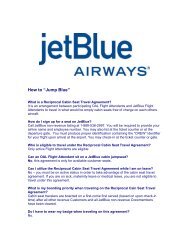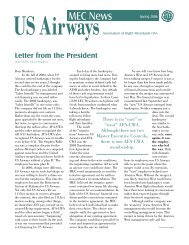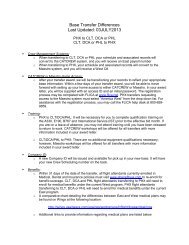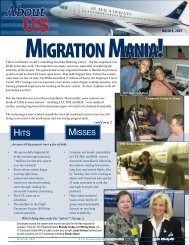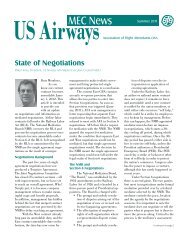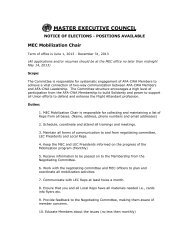update - AFA USAirways
update - AFA USAirways
update - AFA USAirways
Create successful ePaper yourself
Turn your PDF publications into a flip-book with our unique Google optimized e-Paper software.
2<br />
UPDATE<br />
Transforming … where we fly<br />
Focus to shift to larger local markets<br />
Local Markets’ Revenue<br />
<br />
<br />
New York<br />
Local Market Yields Are Higher Than Connect<br />
With Small Local Markets, CLT & PIT Rely More on Connecting Traffic<br />
3,788<br />
Wash, DC<br />
* *<br />
Chicago<br />
LAX<br />
1,683<br />
Dallas<br />
ATL<br />
Domestic Annual O&D Revenue ($mil)<br />
SFO<br />
BOS<br />
*<br />
DEN<br />
Houston<br />
MSP<br />
1,019<br />
PHL<br />
DTW<br />
MIA<br />
SLC<br />
478 473<br />
Like the rest of the so-called legacy carriers, US Airways<br />
primarily operates a hub-and-spoke network. Hundreds of<br />
flights from spoke cities converge in waves many times a day on<br />
our three hubs at Charlotte, Philadelphia and Pittsburgh, where<br />
passengers connect and fly out to their final destination.<br />
While the hub system is a marvelous collector of revenue, it is<br />
also more expensive to operate than point-to-point flights.<br />
Large numbers of gates, equipment and employees are needed<br />
to handle the peaks when aircraft are in the hubs. But during the<br />
down times, these resources sit idle. The hub system also limits<br />
the number of hours per day each aircraft can fly.<br />
Legacy carrier hubs also used to be a “safe haven” to hide in as<br />
the low-cost carriers (LCCs) expanded elsewhere, said Andrew<br />
Nocella, vice president of network and revenue management.<br />
Over the years, US Airways retreated from or downgraded most<br />
of its point-to-point routes to its hubs as low-cost carriers<br />
expanded. “With our hubs now under direct attack from the<br />
LCCs, we no longer have any place to retreat to,” he said.<br />
In the past, the revenue premiums generated by the hub system<br />
more than offset its incremental costs versus a point-to-point<br />
network. This was possible with higher fare levels offered in the<br />
hub local markets in exchange for nonstop service. Further, the<br />
LCCs had not tapped into the revenue stream in many smaller<br />
regional markets in the Northeast. However, this equation has<br />
changed, which requires a transformation of the way we do<br />
business and how we schedule the airline, Nocella explained.<br />
Local market yields (calculated by dividing passenger revenue<br />
by passenger miles and expressed in cents) are higher than in<br />
CLT<br />
PIT<br />
CLE<br />
IND<br />
385<br />
CVG<br />
MEM<br />
* US Airways’ asset strengths<br />
connecting markets. In a hub, the major<br />
carrier can command a premium for<br />
frequent non-stop flights. However,<br />
passengers in spoke cities, who will<br />
likely have to connect at some airline’s<br />
hub to get to their destination, have an<br />
array of choices. Their fares — and the<br />
yield to an airline – are lower, reflecting<br />
this competition.<br />
With their relatively small local market<br />
size, Pittsburgh and Charlotte rely far<br />
more on connecting traffic than<br />
originating passengers. Philadelphia,<br />
meanwhile, is the fifth largest<br />
metropolitan area in the U.S., and<br />
US Airways currently captures 48<br />
percent of the local traffic there.<br />
Under the Transformation Plan,<br />
US Airways’ schedule will be more<br />
focused on larger local markets because<br />
that’s where yields are highest - - and<br />
that is where people want to go. Our<br />
goal is to recapture the number one market share position in<br />
the East through more point-to-point flying and a stronger<br />
focus on LaGuardia, Boston and Washington National with the<br />
US Airways Shuttle as the centerpiece of the operation.<br />
Because of its large population size, Philadelphia will remain at<br />
the core of our network. US Airways has the single largest<br />
number of gates there, including new international and<br />
US Airways Express facilities, and Philadelphia’s geography<br />
also makes it a good gateway city to Europe and the Caribbean.<br />
New York and Washington, D.C., are the nation’s two largest<br />
O&D (origination and destination) markets and Boston is<br />
eighth. US Airways already has a large presence and superb<br />
facilities in all three locations, and these will be leveraged by<br />
providing more point-to-point service. Connecting traffic is<br />
important even in these markets but less so than local<br />
passengers.<br />
Non-stop service will be scheduled to key business and leisure<br />
markets from these three cities. Aircraft utilization will be high<br />
and turn times will be speedy — much like the operations of the<br />
low-cost carriers. The plan includes US Airways returning to<br />
many markets that were abandoned when our costs were higher<br />
than the competition, including New York La Guardia to<br />
Florida, Nocella said.<br />
Under the plan, Charlotte’s strategic position as an effective<br />
hub will permit more Caribbean service and will allow for<br />
more growth of both domestic and international service. It will<br />
operate closer to a traditional hub with more banks, but with<br />
some flattening, or de-peaking of flights, to add efficiency.<br />
Continued on page 3



